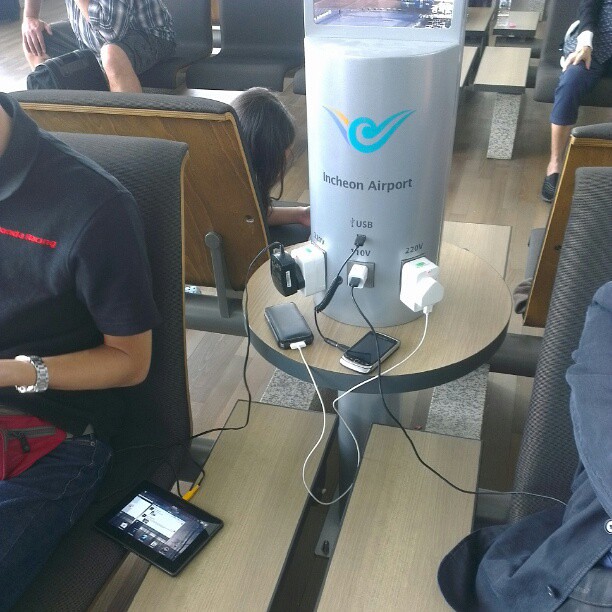I recently started a community arts project working with a group of students and student volunteers at Occidental alongside community artists and technologists to build a bike-powered interactive generator. My role within the project is to manage and help conceptualize all the moving parts, from materials to individuals. I began blogging at MovableParts.org and my first post, also a cross-post here, is about the social implications of the project.
How many times have you gone to a charge station at an airport only to find that all the plugs are being used? Have many conversations not mediated by a cell phone or other mobile computing devices have you witnessed in public spaces lately? It’s true that people don’t engage with one another in an embodied, face-to-face anymore. But sometimes people come into physical proximity when they need something – electricity. They crowd around charge stations or sit awkwardly in spaces around electrical outlets in order to gain access to electricity.

A group of students – Judy Toretti, Jacob Brancasi, Maria Lamadrid, and Cory Bloor – at Art Center College of Design recognized this social pattern and took it to heart in their design of an interactive media system for a homeless youth organization called Jovenes in east LA. Working with the youth participants, the student designers came up with Conversation Space, an interactive cellphone charging booth that requires at least two individuals to step on a foot pedal in order to activate electrical current. The design calls for a coordinated effort on the part of the users. To achieve the common goal of charging cell phones (and other handheld devices critical to the lifeline of homeless youth), users must engage in a face-to-face social interaction. It could be as much as a conversation, as little as a nod, an eye contact, or a chin-up.

The design of Movable Party is meant to accomplish something similar. Like the foot pedal charging booth, our system attempts to transform people’s interactions by redirecting the flow of electricity. We don’t mean this in a strictly physical sense [don’t ask me explain the physics behind the flow of electrons, ask Joe.] What I’m referring to is a design that yields particular desirable social sequences. This design challenges power consumption, a behavioral norm in most public and urban spaces in this country, and shifts our normative relationship to electrical power from consumptive to generative.
Our efforts aim at creating opportunities to generate, instead of compulsively consuming, power. Pedaling is an exciting, eco-friendly, and embodied practice. At an advocacy event like Ciclavia, collective cycling can instantiate the power of human-scale transportation. Moreoever, pedaling comes with a direct consequence of powering a musical performance within our system. This is a participatory event that involves lots of agents including the cyclists on the generator, DJs who will be spinning records, and bystanders and passersby who may be dancing to the music. The embedded sensors and Arduino microcontrollers will interface the system to fine-tune the interactivity among all the participants.
Through a system that re-routes the flow of energy, we hope to articulate the generative impact of pedaling, a goal that involves the translation of the significance of electricity from the physical into the social and symbolic domain. We want people to congregate in a public space. We want them to realize that the outcome of the event – a musical performance – is contingent upon a collaborative process of generating power.
We can’t take electricity for granted. Electricity is not just a physical resource; it is also a kind of social resource that can be harnessed to bring people together. Electricity can be used to power communication that happens in mediated platforms. But we know that already. We hope on at the Ciclavia event on April 21, we will start to see how electrical power plays a critical role in igniting positive and communal social interactions.
* * *
Incidentally, at the airport before my flight took off from LAX, I went looking for an electrical outlet to charge my laptop.
I shared an electrical outlet in the airport terminal with a lady who struck up a friendly conversation with me. “Is that plug available?”
I said, “of course!”
She and I exchanged stories about the overwhelming presence of mediated communication in our society today. She told me that she just saw a mother and her young son of eight or nine years of age dining somewhere. The mother was on the phone the entire time. The son was left to entertain himself.
“Isn’t that ridiculous that we are so dependent on these devices? What did people use to do before cell phones? I guess they talked to people around them,” she remarked.
I said, “It’s funny that we’re talking about this. I’m working on a project that involves the building of a bike generator to power a music event.” I told her the rest of the project.
A few minutes later, with my laptop charged at 84 percent, I disengaged from the electrical outlet and packed up my gear.
Before I scurried off to board my flight, she smiled and said, “good luck with your project!”
Thank you, lady, whoever you are, for your kind reinforcement of the meaning of our project.



 bio
bio